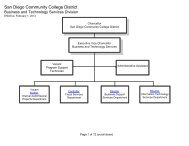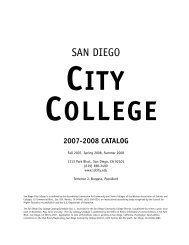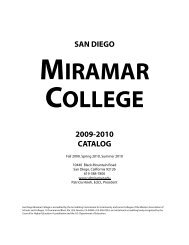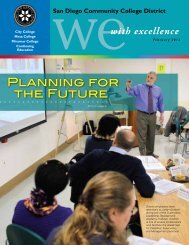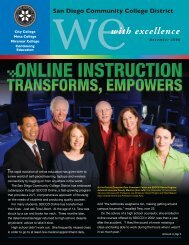The Value of Continuing Education Priceless
The Value of Continuing Education: Priceless - San Diego ...
The Value of Continuing Education: Priceless - San Diego ...
- No tags were found...
You also want an ePaper? Increase the reach of your titles
YUMPU automatically turns print PDFs into web optimized ePapers that Google loves.
San Diego Community College District<br />
City College<br />
Mesa College<br />
Miramar College<br />
<strong>Continuing</strong><br />
<strong>Education</strong><br />
F e b r u a r y 2 0 0 7<br />
<strong>The</strong> <strong>Value</strong> <strong>of</strong> <strong>Continuing</strong> <strong>Education</strong>: <strong>Priceless</strong><br />
SDCCD <strong>Continuing</strong><br />
<strong>Education</strong> helps<br />
better the lives <strong>of</strong> a<br />
large segment <strong>of</strong> all<br />
ages <strong>of</strong> San Diegans.<br />
<strong>Continuing</strong> <strong>Education</strong> Instructor<br />
Toni Hetz, center, demonstrates<br />
electronics assembly to<br />
students. CE classes are for<br />
those interested in advancing<br />
careers, learning new trades or<br />
simply trying something different<br />
in their lives.<br />
<strong>Education</strong>al Cultural Complex (ECC) student<br />
Josephine Okwudu recently won a statewide<br />
essay contest. And what is so special about<br />
her accomplishment goes to the heart <strong>of</strong> what<br />
<strong>Continuing</strong> <strong>Education</strong> is all about.<br />
Josephine is an immigrant from Nigeria, 66,<br />
and an English as a Second Language student at<br />
ECC. Josephine’s winning essay — “How I Have<br />
Changed Since Coming to the United States”<br />
— reflects her path to a better life.<br />
<strong>Continuing</strong> <strong>Education</strong> (CE) has been a big part<br />
<strong>of</strong> Josephine’s transformation as well as for tens <strong>of</strong><br />
thousands <strong>of</strong> others who have attended CE classes<br />
throughout the adult learner program’s 93-year<br />
history.<br />
Take Hiem “Kim” Lam. She came here from<br />
Vietnam at age 21 and turned to <strong>Continuing</strong><br />
<strong>Education</strong> in 2003 to study advanced ESL. Soon<br />
after, Kim enrolled in various CE classes, including<br />
adult basic education, business and beginning<br />
computer use before moving on to City College<br />
in 2004. Now she plans to transfer to San Diego<br />
State University.<br />
<strong>The</strong>re are many such success stories to be found<br />
at all six <strong>Continuing</strong> <strong>Education</strong> campuses, as well<br />
as CE’s 207 community centers.<br />
“<strong>The</strong> mission is important,” CE President<br />
Anthony Beebe stated. “Our task in continuing<br />
education is not to select the students who have<br />
been successful previously, but to help all students<br />
find success. We take all comers, regardless <strong>of</strong> their<br />
academic experience, and work hard to try to<br />
make them successful. This takes some <strong>of</strong> the most<br />
talented faculty anywhere, which we have.”<br />
With annual enrollment typically around<br />
100,000, CE is a well established institution within<br />
the San Diego Community College District.<br />
While CE non-credit courses are free <strong>of</strong> charge,<br />
the fee for community education classes is only<br />
$4.25 per hour <strong>of</strong> instruction. More than 1,200<br />
classes are <strong>of</strong>fered each semester.<br />
Many <strong>of</strong> the classes are taught by working<br />
pr<strong>of</strong>essionals. And a description <strong>of</strong> CE’s <strong>of</strong>ferings<br />
seems almost too good to be true for those<br />
interested in advancing careers, learning new<br />
trades or simply trying something different in<br />
their lives. Even a cursory glance through the<br />
program’s course <strong>of</strong>ferings illustrates the diversity<br />
<strong>of</strong> classes, everything from computers to acrylics,<br />
from cooking to steel fabrication, from piano to<br />
foster parenting.<br />
“<strong>Continuing</strong> <strong>Education</strong> is a mechanism,” Beebe<br />
says, “to help students find their pathways to other<br />
learning opportunities or jobs.” And the numbers<br />
illustrate that students are taking those paths.<br />
In fall 2005, there were 5,388 students enrolled<br />
in credit classes at colleges within SDCCD who<br />
had previously been enrolled in CE non-credit<br />
classes. <strong>The</strong>re were also 1,637 students who were<br />
continued on page 4<br />
We—With Excellence | FEBRUARY 2007
C h a n c e l l o r ’ s M e s s a g e<br />
Origin <strong>of</strong> a <strong>Continuing</strong> <strong>Education</strong><br />
Constance M. Carroll, Ph.D.<br />
Chancellor,<br />
San Diego Community<br />
College District<br />
Because <strong>of</strong><br />
the decision<br />
to take<br />
responsibility<br />
for adult and<br />
continuing<br />
education for<br />
the region,<br />
our district<br />
has become<br />
a gateway to<br />
opportunity for<br />
a wide variety<br />
<strong>of</strong> people.<br />
In the late 1960s and early 1970s many <strong>of</strong> California’s<br />
community college districts made the transition<br />
from being part <strong>of</strong> their local school districts to<br />
becoming independent institutions. In November<br />
1972, the voters approved separating the San Diego<br />
Community College District from the San Diego<br />
Unified School District, changing forever the<br />
direction and destiny <strong>of</strong> what has since become the<br />
state’s second largest community college district.<br />
During this same period <strong>of</strong> time, California’s<br />
community college districts and the local K-12<br />
school districts faced another critical decision. While<br />
it was clear that community colleges should take<br />
responsibility for all instruction for grades 13 and 14,<br />
it was not at all apparent as to which entity should<br />
administer adult education programs. On the one<br />
hand, school districts had a long history <strong>of</strong> expertise<br />
in adult education; on the other, community colleges<br />
specialized in serving a student population <strong>of</strong> adults.<br />
Because there was no clear answer to this question,<br />
the state permitted the school and community<br />
college districts to negotiate this organizational<br />
decision on a case-by-case basis.<br />
ECC graduates<br />
receive high<br />
school diplomas<br />
at <strong>Continuing</strong><br />
<strong>Education</strong>’s 2006<br />
commencement.<br />
While many school districts throughout the<br />
state opted to continue managing adult education<br />
programs, the San Diego Community College<br />
District was among a smaller group <strong>of</strong> community<br />
college districts that negotiated the right to <strong>of</strong>fer<br />
adult education programs under the aegis <strong>of</strong> the<br />
community college organization. <strong>The</strong> rest, as they say,<br />
is history.<br />
With 50,000 students enrolled in its three credit<br />
colleges (City, Mesa and Miramar), the San Diego<br />
Community College District also serves another<br />
50,000 students who enroll in a wide variety <strong>of</strong><br />
adult education and other noncredit programs<br />
within its <strong>Continuing</strong> <strong>Education</strong> Division. Because<br />
<strong>of</strong> this structure, our district has become a gateway<br />
to opportunity for a wide variety <strong>of</strong> people: new<br />
immigrants learning English and preparing for<br />
citizenship; returning veterans; high school drop<br />
outs; older adults; young people whose goal is to<br />
transfer; people <strong>of</strong> all ages who are preparing for the<br />
workforce; and employed people who are upgrading<br />
their job skills. Our instructional levels span a<br />
similarly broad range from basic skills to honors.<br />
<strong>The</strong> extensive scope and comprehensiveness <strong>of</strong><br />
the San Diego Community College District are the<br />
result <strong>of</strong> its excellent community colleges, as well as<br />
the extremely important decision, made over three<br />
decades ago, to take responsibility for adult and<br />
continuing education for the region.<br />
<br />
san diego community college district
SPOTLIGHT<br />
F r o n t & C e n t e r<br />
City College cares<br />
about students and<br />
always goes the<br />
extra mile to help<br />
them to achieve their<br />
educational goals.<br />
<strong>The</strong> WE — with excellence<br />
newsletters are also online,<br />
dating back to 2000. Go<br />
to the SDCCD homepage<br />
(www.sdccd.edu) and click<br />
on the red “WE online” box<br />
near the bottom right <strong>of</strong> the<br />
homepage.<br />
Design Students Help Hurricane Victim<br />
When Hurricane Katrina wreaked havoc in fall<br />
2005, City College graphic design students and<br />
faculty decided to help. <strong>The</strong> students put out the<br />
word that they wanted to bring a displaced design<br />
student to City College.<br />
Word reached Nunez Community College<br />
Pr<strong>of</strong>essor Amy Pecquet in New Orleans. She<br />
Graphic design student Elton Fletcher<br />
informed Elton Fletcher, one <strong>of</strong> her most<br />
promising graphic design students, who contacted<br />
City College.<br />
Help could not have come at a better time for<br />
the 30-year-old hurricane victim. Fletcher had<br />
evacuated to Houston with 21 family members,<br />
including a grandmother, aunts and cousins.<br />
Thanks to City graphic design students and<br />
faculty, Fletcher was able to continue his studies<br />
throughout 2006 at City. “It’s been quite an<br />
experience. <strong>The</strong> amazing people at City, and my<br />
family, have shown incredible strength.”<br />
His studies last fall, however, were jeopardized<br />
because the state did not continue to waive<br />
nonresident student fees for Katrina victims in<br />
California colleges. Legislation to reinstitute the<br />
waiver was vetoed in October. Elton could not<br />
afford nonresident fees — $160 per unit.<br />
<strong>The</strong> college came to Fletcher’s aid, as well as<br />
the two other hurricane victims enrolled at City<br />
College. <strong>The</strong>ir Fall 2006 fees were covered by<br />
$1,500 in City scholarships. Each student received<br />
about $500. This spring semester, they became<br />
state residents and eligible for the $20 per unit<br />
resident fee.<br />
“I am extremely pleased that City College has<br />
been able to creatively address our three students’<br />
financial burden and assure that their education<br />
continues uninterrupted,” City College President<br />
Terry Burgess stated. “City College cares about<br />
students and always goes the extra mile to help<br />
them achieve their educational goals.”<br />
City Graphic Arts<br />
Pr<strong>of</strong>essor Candice Lopez<br />
said Fletcher is thriving.<br />
“Elton has been a joy<br />
to work with and has<br />
made the most <strong>of</strong> this<br />
opportunity. He is<br />
talented and dedicated.”<br />
Design student Sondra<br />
Lagnado said, “Elton is<br />
a wonderful, optimistic<br />
person. It touches my<br />
heart when I see him<br />
around campus. More<br />
importantly, it is not what we did for Elton; it is<br />
what Elton has given us.”<br />
Classmate Brody Albert said, “At first I thought<br />
I was helping out someone in need, but now that<br />
he’s here, and we’ve become friends, I realize<br />
that he has gifted me with much more than I<br />
have given him. Every time we hang out I learn<br />
something new.”<br />
Led by Pr<strong>of</strong>. Lopez, students, faculty and<br />
others have helped Fletcher with living and school<br />
arrangements and provided financial support<br />
for books, household items and food.<br />
“<strong>The</strong>se people have taken me under their<br />
wings,” Fletcher said. “I’ve already made life-long<br />
friends.”<br />
He plans to help family members re-establish<br />
themselves in New Orleans. “New Orleans is a<br />
great city. I’m confident it will be rebuilt better<br />
than ever.”<br />
Fletcher has also been impressed with the<br />
spirit <strong>of</strong> City students. “<strong>The</strong>y are very dedicated,<br />
very focused. I saw immediately that they mean<br />
business. Hurricane Katrina changed my life, and<br />
now San Diego has changed my perspective with<br />
its generosity.”<br />
We—With Excellence | FEBRUARY 2007
Virtually all <strong>of</strong> the<br />
instructors are<br />
employed in the<br />
field, so students<br />
get the benefit <strong>of</strong><br />
their day-to-day<br />
experience.<br />
continued from page 1<br />
simultaneously enrolled in college courses and<br />
<strong>Continuing</strong> <strong>Education</strong> non-credit classes.<br />
CE also <strong>of</strong>fers specific-needs courses for already<br />
trained pr<strong>of</strong>essionals – such as information<br />
technology pr<strong>of</strong>essionals and employees <strong>of</strong><br />
General Dynamics NASSCO.<br />
Under a recently devised “Cornerstones for the<br />
Future” plan, CE staff and administrators seek to<br />
increase pr<strong>of</strong>essional development, expand course<br />
diversity, enhance image and grow enrollments.<br />
After polling faculty and staff — estimated<br />
at 800 — Dr. Beebe reported that the people<br />
<strong>of</strong> <strong>Continuing</strong> <strong>Education</strong> were identified as the<br />
program’s number one strength. “Now, how<br />
can we make those people even<br />
stronger?”<br />
“We’re keeping up with the<br />
changes that are necessary, and<br />
we’re doing so in large part from<br />
student feedback,” said Valerie<br />
Edinger, the vice president <strong>of</strong><br />
instruction and student services.<br />
“We’re listening to what is going<br />
on out there, and the students and<br />
pr<strong>of</strong>essors are providing excellent<br />
ideas.”<br />
Dean <strong>of</strong> Student Development<br />
and Matriculation Marcia Biller<br />
stated, “We help people go where<br />
they really want to get. We enjoy<br />
a strong, organized counseling<br />
system. We have a career<br />
development and placement<br />
service so that people can move<br />
from our programs directly into<br />
the work. If the goal is to work<br />
in a certain field, we have designed the necessary<br />
career ladder. We help students who have an<br />
interest in a certain field refocus and understand<br />
how they can make a successful career in that<br />
field.”<br />
Administrators say that<br />
word-<strong>of</strong>-mouth has served as<br />
an excellent tool for introducing<br />
new students to the program.<br />
“We’re also very thorough<br />
in our orientations,” Biller said.<br />
“<strong>The</strong>re is much more to know<br />
than where the classroom is, and<br />
we try to give the students as<br />
much information as possible.”<br />
Interdisciplinary<br />
collaborations are increasing,<br />
Biller reported, meaning<br />
programs within the<br />
departments are working<br />
together more than ever,<br />
especially as technology<br />
introduces more synergy between pr<strong>of</strong>essions.<br />
“<strong>The</strong> counselors and the faculty work together<br />
so that we can share the more intricate details <strong>of</strong><br />
what is going on in certain pr<strong>of</strong>essions, and how<br />
technology and other advances are changing those<br />
pr<strong>of</strong>essions,” Biller said.<br />
At North City campus, for example, updates<br />
occur frequently.<br />
“We <strong>of</strong>fer literally hundreds <strong>of</strong> short-term<br />
courses aimed at helping people get up to speed<br />
with new computer s<strong>of</strong>tware,” said Jim Vincent,<br />
dean <strong>of</strong> the North City campus. “Virtually all <strong>of</strong><br />
our instructors are employed in the field, so we get<br />
the benefit <strong>of</strong> their day-to-day experience.”<br />
<br />
san diego community college district
N e w s f r o m C i t y C o l l e g e<br />
Terrence J. Burgess<br />
President<br />
San Diego City College<br />
An architect’s rendering depicts<br />
City College’s new Vocational<br />
Technology Center, which will be<br />
located on the southeast corner<br />
<strong>of</strong> the campus.<br />
Campus Footprint About to Grow<br />
City College has embarked on a major period<br />
<strong>of</strong> construction that will expand the size <strong>of</strong> the<br />
campus and allow for much-needed expansion <strong>of</strong><br />
programs and services.<br />
“At 93 years young, City College has begun<br />
a historic development era to help meet the<br />
demands <strong>of</strong> our growing campus,” City College<br />
President Terry Burgess stated.<br />
First to be constructed is a five-story, 88,000<br />
square foot Vocational Technology Center (VTC),<br />
which will centralize and allow for expansion <strong>of</strong><br />
key vocational programs, including cosmetology,<br />
nursing and photography.<br />
Further, the development will also provide 700<br />
new parking spaces and incorporate a new center<br />
<strong>of</strong> operations for campus police.<br />
<strong>The</strong> Vocational Technology Center will be<br />
located on the newly acquired city block across<br />
the street from the current southeast corner <strong>of</strong> the<br />
campus, bordered by 16th and 17th streets, and<br />
Broadway and C streets. Funded by Proposition<br />
S bond monies, construction cost is estimated<br />
between $51.5 to $54.5 million.<br />
Groundbreaking is projected for early 2008<br />
while construction is expected to take about 18<br />
months.<br />
President Burgess pointed out that the<br />
multilevel building will capitalize on the college’s<br />
vision for 16th Street to evolve into a pedestrianfriendly<br />
passage. A landscaped plaza, located at<br />
the southern portion <strong>of</strong> 16th Street and adjacent<br />
to Broadway will serve VTC students and staff and<br />
provide a gateway image to the rapidly developing<br />
East Village.<br />
Plans call for cosmetology to be located on<br />
the first two levels, nursing on the third story and<br />
photography on the fourth and fifth levels. <strong>The</strong><br />
first level is planned as a salon for cosmetology<br />
students to provide retail service to the public.<br />
Above the street, all levels are linked by a glazed<br />
stairwell located adjacent to the building entrance<br />
on 16th Street. <strong>The</strong> stairwell connects to a student<br />
gathering space on each level, providing a “hub”<br />
<strong>of</strong> activity for daily use and incorporating natural<br />
light as a feature <strong>of</strong> building circulation.<br />
<strong>The</strong> expansion is welcome. Nursing currently<br />
has more than a two-year waiting list while<br />
cosmetology students require additional<br />
workspace. And photography students will have a<br />
display gallery for showcasing their award-winning<br />
works.<br />
Chancellor Constance Carroll said that<br />
“City College is recognized as one <strong>of</strong> the best<br />
community colleges in the nation, especially for<br />
some <strong>of</strong> its unique vocational programs. <strong>The</strong><br />
nursing, cosmetology and photography<br />
departments are excellent and deserve highquality<br />
facilities to match the high quality <strong>of</strong> the<br />
instruction provided.”<br />
<strong>The</strong> VTC is the first significant step toward<br />
implementing the 2005 City College facilities<br />
master plan, which calls for modernization and<br />
expansion <strong>of</strong> infrastructure and new facilities to<br />
accommodate an eventual student population<br />
<strong>of</strong> 25,000 in the next decade, according to<br />
administrators. Currently, City’s enrollment is<br />
estimated at 16,000.<br />
We—With Excellence | FEBRUARY 2007
N e w s f r o m M e s a C o l l e g e<br />
Rita M. Cepeda, Ed.D.<br />
President<br />
San Diego Mesa College<br />
Greening Mesa<br />
In a January 8 decision,<br />
the San Diego City Council<br />
agreed to sell the SDCCD<br />
2.7 acres for $1.07 million<br />
and to allow a Mesa<br />
College parking structure<br />
to be built on a sliver <strong>of</strong><br />
environmentally sensitive<br />
canyon land. In exchange,<br />
SDCCD and the college will<br />
create a number <strong>of</strong> projects<br />
and programs that will<br />
benefit the local community.<br />
This includes expansion<br />
<strong>of</strong> the Multiple Habitat<br />
Planning Area (MHPA) on<br />
SDCCD land; establishment<br />
<strong>of</strong> a campus carbon neutral<br />
program to neutralize<br />
emissions <strong>of</strong> carbon dioxide;<br />
removal <strong>of</strong> palm trees from<br />
parts <strong>of</strong> Tecolote Canyon;<br />
additional landscaping <strong>of</strong><br />
neighboring Kearny Mesa<br />
Park; and the creation <strong>of</strong><br />
an annual “Canyon Day for<br />
Kids” educational event.<br />
Community groups will also<br />
be involved in developing<br />
landscaping plans, plus<br />
neighbors will have free<br />
use <strong>of</strong> the campus parking<br />
facility on weekends and<br />
holidays.<br />
Parking Space: the Final<br />
Frontier — Green-Lighted<br />
For more than 25 years, students have struggled<br />
to find a place to park at San Diego Mesa College<br />
while faculty and staff were also adversely<br />
impacted in a variety <strong>of</strong> ways.<br />
Many have said that parking permits are<br />
regarded not as a means to find parking but as a<br />
license to hunt for parking.<br />
For decades frustrated college <strong>of</strong>ficials have<br />
resorted to a host <strong>of</strong> creative efforts to ease<br />
parking problems that have regularly reached<br />
<strong>The</strong> Mesa College parking structure (depicted in rendering) is considered a<br />
cornerstone <strong>of</strong> the Mesa College Facility Master Plan.<br />
crisis proportions. For at least the past seven years,<br />
this included providing a free shuttle service for<br />
students who parked in sanctioned <strong>of</strong>f-campus<br />
lots, primarily Kearny High School.<br />
With funding secured by the 2002 passage <strong>of</strong><br />
Proposition S, plans began in earnest to design<br />
and build a parking structure. After several years<br />
<strong>of</strong> study and advocacy by various campus and<br />
<strong>of</strong>f-campus groups and numerous community<br />
meetings (23 since July 2004), Mesa College has<br />
the green light.<br />
On January 8, the San Diego City Council<br />
approved the SDCCD’s request to build a fourlevel<br />
parking facility where Mesa College Drive<br />
dead ends at Tecolote Canyon.<br />
“Erecting a parking structure that would<br />
accommodate the needs <strong>of</strong> our students, assuage<br />
the concerns <strong>of</strong> our neighbors and permit the<br />
reconfiguration <strong>of</strong> the east entrance to the<br />
college — while maintaining and improving the<br />
environmental integrity <strong>of</strong> the canyon — has been<br />
no easy feat,” says Mesa College President Rita<br />
Cepeda.<br />
She credits numerous individuals, who, under<br />
the direction <strong>of</strong> Damon Schamu, SDCCD Vice<br />
Chancellor <strong>of</strong> Facilities, worked arduously to keep<br />
the construction project on track. At a District<br />
Board <strong>of</strong> Trustees<br />
meeting on January<br />
25, President Cepeda<br />
also acknowledged and<br />
thanked Chancellor<br />
Constance Carroll and<br />
members <strong>of</strong> the SDCCD<br />
Board <strong>of</strong> Trustees<br />
for their leadership,<br />
perseverance, patience<br />
and tenacity.<br />
Testimony by Mesa<br />
College student leaders<br />
before the City Council<br />
also proved invaluable as<br />
they recounted their personal battles with parking<br />
and their concern with safety. “Students love for<br />
the environment and their delight with the design<br />
<strong>of</strong> a ‘green’ structure helped to convince Council<br />
members that the proposed project represents a<br />
thoughtful, responsible, ecologically sound and<br />
much-needed facility for the future <strong>of</strong> our college,”<br />
Dr. Cepeda stated.<br />
Groundbreaking is expected in August,<br />
while construction is slated for completion<br />
by October 2008. <strong>The</strong> facility will provide<br />
an additional 1,066 parking spaces for a campuswide<br />
total <strong>of</strong> 4,605 available spaces for students,<br />
faculty and staff, and will also house the college’s<br />
police headquarters.<br />
<br />
san diego community college district
N e w s f r o m M i r a m a r C o l l e g e<br />
Patricia Hsieh, Ed.D.<br />
President<br />
San Diego Miramar College<br />
Big Day for Miramar College<br />
On January 22 at opposite ends <strong>of</strong> the Miramar<br />
campus, construction activity began for two longawaited<br />
projects — the Leave a Legacy Plaza and<br />
the 54,000 square foot Hourglass Fieldhouse.<br />
Leave a Legacy Plaza, a park-like open space<br />
to be landscaped with grassy areas, trellises and<br />
a unique water feature, has been designed to<br />
encourage quiet conversation or reflection and<br />
will provide easy access to nearby instructional<br />
facilities and parking. Originally conceived by the<br />
Miramar College Foundation, the plaza provides<br />
an opportunity to honor graduates, family<br />
members and friends, or celebrate a special event<br />
or memory in a unique and lasting way through<br />
Plans for Leave a Legacy Plaza<br />
laser-engraved bricks, sponsored trees, benches<br />
and flags.<br />
Celebrating involvement in the college and a<br />
commitment to education, each brick sponsor<br />
will receive an identical mini-replica keepsake,<br />
reprising their message. All funds raised through<br />
sponsored bricks will support scholarships,<br />
technology improvements and program<br />
innovation. Construction <strong>of</strong> the Plaza is expected<br />
to start in late August with a grand opening<br />
celebration being planned for September.<br />
<strong>The</strong> Fieldhouse project is the third and final<br />
phase <strong>of</strong> the 32-acre Hourglass Park athletics<br />
complex, which includes a gymnasium, team<br />
locker rooms, physical therapy room, fitness<br />
center, dance and aerobics room, <strong>of</strong>fice space<br />
for 14 faculty and staff and a shared use parking<br />
facility to accommodate 370 vehicles. Hourglass<br />
Park is a joint development with the City <strong>of</strong> San<br />
Diego park and recreation department.<br />
Phase one opened in 1994 with multi-use ball<br />
fields, volleyball courts, a snack bar, children’s<br />
play areas and open park space. <strong>The</strong> second phase,<br />
the $4 million, three-pool Ned Baumer Miramar<br />
College Aquatic Center, opened in 1999.<br />
Completion <strong>of</strong> the Hourglass athletics complex<br />
will allow for the addition <strong>of</strong> more Miramar<br />
intercollegiate sports teams. Currently, the college<br />
<strong>of</strong>fers men’s and women’s water polo and men’s<br />
basketball, now in its inaugural season. Because<br />
the college does not yet have a gym, basketball<br />
home games are played at Scripps Ranch High<br />
School while practice is held at nearby Alliant<br />
University. A men’s and women’s swim team will<br />
debut this spring.<br />
A groundbreaking ceremony for the Hourglass<br />
Fieldhouse is being planned for mid-March.<br />
Completion is anticipated in June 2008.<br />
Construction costs <strong>of</strong> the Leave a Legacy<br />
Plaza is estimated at $18.59 million. Hourglass<br />
Fieldhouse is being funded by Proposition S and is<br />
expected to cost $1.1 million.<br />
We—With Excellence | FEBRUARY 2007
N e w s f r o m C o n t i n u i n g E d u c a t i o n<br />
Anthony E. Beebe, Ed.D.<br />
President<br />
San Diego <strong>Continuing</strong> <strong>Education</strong><br />
Pr<strong>of</strong>essor Starlene Dahl with<br />
ESL students.<br />
Retirement to “Rewirement”<br />
Starlene Dahl worked for the City <strong>of</strong> San Diego<br />
for 26 years in progressively more responsible<br />
positions from budget and financial analyst to<br />
management analyst. She would make budget<br />
proposals and recommendations to managers. She<br />
would monitor grant proposals and funding and<br />
charges.<br />
Starlene had excellent skills, job security,<br />
respect, but she realized she was not happy.<br />
Widowed at an early age, Starlene decided<br />
that while her job provided financial stability,<br />
she wanted to see what else there was for her<br />
to do — to feed her soul. She decided that she<br />
would retire from the City at age 55 and “do<br />
what I really want to do, while I could.” Three<br />
years prior to her anticipated departure date, she<br />
attended workshops and counseling at the Metro<br />
Career Center that was located on Aero Drive.<br />
Through assessment testing and conversation she<br />
discovered her aptitude and interests were for<br />
teaching English as a Second Language (ESL).<br />
ESL Pr<strong>of</strong>essor Richie Mitchell, who teaches<br />
at North City campus, recognized something in<br />
Starlene that was genuine and invited Starlene to<br />
observe her class.<br />
Starlene recalled, “I was captivated by the pure<br />
love <strong>of</strong> learning in that classroom. <strong>The</strong> students<br />
were so enthusiastic, so excited and so grateful.<br />
<strong>The</strong>y were identifying pictures on flash cards,<br />
learning the most basic English words and phrases,<br />
and they were glowing. I could picture myself as<br />
their teacher.” While still employed at the City,<br />
she enrolled in the TOEFL (Teachers <strong>of</strong> English as<br />
Foreign Language) training program at UCSD. She<br />
also served 60 hours as an observer and un<strong>of</strong>ficial<br />
aid to ESL classes at Mid-City campus in City<br />
Heights.<br />
“I was overwhelmed by the gratitude,<br />
cooperation, and learning that was going on…not<br />
only English, but how<br />
“I was<br />
to get along with other<br />
captivated by cultures and how to adapt<br />
to living in America as well.<br />
the pure love<br />
I would be engrossed in<br />
<strong>of</strong> learning helping, and I would hear<br />
in that<br />
‘thank you, teacher,’ and<br />
not realize that they were<br />
classroom.<br />
talking to me. I wasn’t a<br />
<strong>The</strong> students teacher, at least not yet.<br />
were so<br />
But they respected me and<br />
what I was doing in the<br />
enthusiastic,<br />
classroom.”<br />
so excited Four-and-a-half<br />
months prior to her<br />
and so<br />
scheduled retirement<br />
grateful.” from the City, Starlene<br />
was <strong>of</strong>fered a class in<br />
pronunciation by the late Nancy Bachman, then<br />
instructional leader for ESL at North City Campus.<br />
“I figured out how to exit my job and begin my<br />
career as a teacher.<br />
“I’ve never looked back. I was so nervous<br />
that first Saturday up in Mira Mesa. But a<br />
student smile, and a ‘thank you teacher,’ makes<br />
it worthwhile every single time I step in the<br />
classroom.”<br />
Since teaching that first class two years ago,<br />
Starlene has already been <strong>of</strong>fered and accepted a<br />
second ESL class at the Clairemont campus.<br />
<br />
san diego community college district
kudos<br />
A c c o m p l i s h m e n t s & A c h i e v e m e n t s<br />
District Campuses<br />
Make a Big Showing<br />
at the Martin Luther<br />
King Day Parade<br />
City College and Mesa College students, faculty and staff were part <strong>of</strong> the SDCCD’s large<br />
contingent that took part in the Dr. Martin Luther King, Jr. Parade held downtown in<br />
January. Mesa’s entry was awarded second place in the parade’s education division while<br />
City placed third. Miramar College, <strong>Continuing</strong> <strong>Education</strong>, District Offices and members<br />
<strong>of</strong> the Board <strong>of</strong> Trustees also took part in the annual event, including Trustees Marty Block,<br />
Rich Grosch, Bill Schwandt and Peter Zschiesche, as well as Chancellor Constance Carroll.<br />
New Commencement<br />
Venue at Miramar<br />
Weather concerns, combined with<br />
impending construction projects, means<br />
that Miramar College’s commencement<br />
will be moved <strong>of</strong>f campus and indoors for<br />
the May 31 ceremonies. <strong>The</strong> Torrey Pines<br />
Hilton Ballroom is this year’s site. Miramar<br />
alumna Tracy Jarman, recently appointed<br />
Fire Chief <strong>of</strong> the City <strong>of</strong> San Diego Fire-<br />
Rescue Department, is scheduled as<br />
Commencement Speaker. Recently, Chief<br />
Jarman was named the college’s 2007<br />
distinguished alumnus.<br />
City Among Top<br />
Nationally<br />
As the only community college on the<br />
2006 list, City College was ranked among<br />
the top 20 institutions in the United States<br />
for the number <strong>of</strong> Benjamin A. Gilman<br />
Scholarship participants. Sponsored by<br />
the federal government, this nationwide<br />
competition provides thousands <strong>of</strong> dollars<br />
for students to study abroad. Four City<br />
College students earned the prestigious<br />
Gilman scholarship in 2006 and one<br />
in 2007.<br />
City College International <strong>Education</strong><br />
Coordinator Marion Froelich reported that<br />
City students most recently studied in Italy,<br />
Spain and southern Mexico.<br />
Child Center<br />
Recognized<br />
City College’s Child Development Center<br />
was recently honored by the San Diego<br />
Association for the <strong>Education</strong> <strong>of</strong> Young<br />
Children for its collaboration with the<br />
YMCA Childcare Resource Service in<br />
providing services to families and children.<br />
Child Development Center Director<br />
Gloria Lyon accepted the honor on behalf<br />
<strong>of</strong> the college’s child development center.<br />
National Conference<br />
Heads to Miramar<br />
Miramar Pr<strong>of</strong>essor Kevin Petti is conference<br />
coordinator for the 21st annual meeting<br />
<strong>of</strong> the Human Anatomy and Physiology<br />
Society, which will be held on campus<br />
May 26-30. More than 350 educators from<br />
colleges and universities across the country<br />
will attend workshops<br />
on the latest<br />
developments<br />
in the health<br />
and science<br />
fields. Dr. Petti<br />
worked with<br />
a Canadian<br />
graphic arts<br />
firm, Imagineering Media Services,<br />
to develop the clever conference logo.<br />
We—With Excellence | FEBRUARY 2007
kudos<br />
A c c o m p l i s h m e n t s & A c h i e v e m e n t s<br />
All in the Family<br />
Cycling is a passion for Mesa College Music<br />
Pr<strong>of</strong>essor James Romeo, and his wife,<br />
Angela Liewen-Romeo, an instructional<br />
lab technician at the college. <strong>The</strong> middleaged<br />
couple took up racing about two years<br />
ago, but have quickly advanced to winner<br />
circles, taking home some <strong>of</strong> California’s<br />
top honors.<br />
Throughout the past year, Pr<strong>of</strong>essor<br />
Romeo participated in more than 20<br />
races. He won silver and bronze medals<br />
at the California State Masters Track<br />
Championships, competing in match<br />
sprints and 500-meter sprints. He is<br />
a member <strong>of</strong> the over-35 San Diego<br />
Cyclo-vets and is coached by Eddie “B”<br />
Borysewicz, 1984 U. S. Olympic bicycling<br />
team head coach and current Polish<br />
National team head coach.<br />
Angela is a member <strong>of</strong> an all-women’s<br />
team based in Burbank. She scored her first<br />
win at the Ontario Grand Prix in July and<br />
competed in nearly 40 races during the<br />
2006 cycling season. She went on to receive<br />
enough points to lead her category in the<br />
Music Pr<strong>of</strong>essor James Romeo, above, won silver<br />
and bronze medals in the California State Masters<br />
Track summer 2006 competition.<br />
Mesa College Instructional Lab Technician Angela<br />
Liewen-Romeo, right, celebrates her first win — the<br />
Ontario Grand Prix last July in Ontario, California.<br />
prestigious SoCal Cup, ranking number<br />
one over 160 riders.<br />
<strong>The</strong> pair trains five to seven days a<br />
week — during lunch, after work and on<br />
weekends, when they take on grueling<br />
routes in the Ramona backcountry or train<br />
at the Velodrome in Balboa Park.<br />
“It has taught me about setting goals,<br />
and reaching and attaining them,” said<br />
Liewen-Romeo.<br />
Statewide Honors for Miramar Alumnus<br />
San Diego Mayor Jerry Sanders, a Miramar College alumnus, has received the prestigious California Community College Distinguished<br />
Alumni Award for 2006. He was honored recently at the Community College League <strong>of</strong> California annual convention in Costa Mesa.<br />
Mayor Sanders was selected for the statewide honor for his more than 30 years <strong>of</strong> career leadership in public safety, charitable<br />
organizations, community service, and now as mayor <strong>of</strong> one <strong>of</strong> the largest<br />
cities in the nation.<br />
Career achievements, pr<strong>of</strong>essional standing and contributions to<br />
community that transcend the norm were the criteria used to qualify for<br />
the statewide recognition.<br />
<strong>The</strong> former San Diego police chief is the first graduate <strong>of</strong> a San Diego<br />
Community College District college to receive the state award since 1964,<br />
when City College alumnus Predrag Mitrovich, vice president <strong>of</strong> San Diego<br />
First National Bank was selected.<br />
Mayor Sanders was also honored by the Miramar College Foundation<br />
this month at an Outstanding Leaders Award Luncheon held at the Joan<br />
Kroc Institute for Peace and Justice. <strong>The</strong> event raised nearly $6,000 for<br />
Foundation scholarships, including a new Outstanding Leadership award<br />
for a deserving Miramar College student.<br />
San Diego Mayor Jerry Sanders speaks at a Miramar College<br />
Foundation luncheon held to honor him as a distinguished Miramar<br />
alumnus. On the far left is San Diego Sheriff Bill Kolender.<br />
10 san diego community college district
kudos<br />
A c c o m p l i s h m e n t s & A c h i e v e m e n t s<br />
Miramar Elections,<br />
Appointments<br />
Richard Bettendorf, dean <strong>of</strong> Technical<br />
Careers and Workforce Initiatives, has been<br />
appointed Region X representative to the<br />
state Chancellor’s Office Resource Group<br />
for Career Technical <strong>Education</strong>.<br />
He was also recently elected regional<br />
vice president <strong>of</strong> California Community<br />
Colleges Association for Occupational<br />
<strong>Education</strong>.<br />
EOPS Director Joan Thompson<br />
will participate in a People to People<br />
Ambassador delegation to China this<br />
summer to learn more about women’s<br />
representation and participation in higher<br />
education in that nation.<br />
Interim Vice President for Instruction<br />
Kit Foster was recently inducted into<br />
Altrusa International <strong>of</strong> San Diego, a<br />
community organization which supports<br />
local charities that serve literacy and<br />
children’s health.<br />
ECC Teacher Takes<br />
Top State Honors<br />
Beth Bogage, an advanced level ESL<br />
instructor at the <strong>Education</strong>al Cultural<br />
Complex, has won the annual Norma<br />
Shapiro Memorial Award for Adult Level<br />
ESL Pr<strong>of</strong>essionals.<br />
California Teachers <strong>of</strong> English to<br />
Speakers <strong>of</strong> Other Languages (CATESOL)<br />
created the Shapiro award for an ESL<br />
Adult Level pr<strong>of</strong>essional with five or fewer<br />
years <strong>of</strong> experience in the field who has<br />
demonstrated excellence in teaching,<br />
training and/or writing and plan to make<br />
teaching English as a Second Language<br />
their career.<br />
Beth is scheduled to be recognized at the<br />
CATESOL Conference, set in April in San<br />
Diego, plus receive a library <strong>of</strong> pr<strong>of</strong>essional<br />
ESL books.<br />
It’s Designing<br />
Cats and Dogs<br />
Mesa College interior design students and<br />
graduates can be found practicing in a wide<br />
variety <strong>of</strong> interior design specialties. Now,<br />
we can add critter habitats to the list.<br />
Pr<strong>of</strong>essors Kim Hansen, left, and Mimi Moore<br />
inside the cat habitat designed by Hansen.<br />
During a weeklong decorating frenzy in<br />
January, 25 Mesa interior design students,<br />
alumni and faculty were among 40<br />
designers who refurbished the San Diego<br />
Humane Society’s 24 dog habitats and 15<br />
cat rooms.<br />
Five Mesa students redecorated a cat<br />
room, while 13 habitats were designed by<br />
17 Mesa alumni.<br />
<strong>The</strong> pro-bono redesign challenged<br />
student and pr<strong>of</strong>essional designers to<br />
build beautiful and whimsical habitats that<br />
promote the human-animal bond while<br />
also maintaining animal safety and habitat<br />
durability.<br />
Mesa Pr<strong>of</strong>essor Kim Hansen created<br />
the “Australian Rolling Hills” habitat.<br />
Other notable décor themes included the<br />
Mad Hatter’s tea party, an Arabian Nights<br />
fantasy, Central Park and a jungle.<br />
<strong>The</strong> annual American Society <strong>of</strong> Interior<br />
Design (ASID) local chapter’s community<br />
service project was coordinated by Mesa<br />
graduate Stefanie Wenceslao. Current<br />
chapter president, Nina Closer, is also a<br />
Mesa graduate.<br />
Mesa College’s strong presence in ASID<br />
community service projects primarily is<br />
due to Mesa Interior Design Pr<strong>of</strong>essor<br />
Mimi Moore. “Community service is built<br />
into our program,” she said.<br />
New Skills Center<br />
Complex for <strong>Continuing</strong> <strong>Education</strong><br />
Construction <strong>of</strong> the new <strong>Continuing</strong> <strong>Education</strong> Skills Center (rendering pictured) could<br />
begin this year. <strong>The</strong> complex replaces the current skills center located at the Centre City<br />
Campus near City College. <strong>The</strong> new center will consist <strong>of</strong> three buildings to house the<br />
automotive and appliance repair programs and the business information technology,<br />
CISCO, graphics and electronic assembly classes. To make room for the new skills center,<br />
land was acquired along the east end <strong>of</strong> the ECC campus, and 16 structures were demolished<br />
as part <strong>of</strong> a two-year process.<br />
We—With Excellence | FEBRUARY 2007 11
connections<br />
A l u m n i U p d a t e s & A c h i e v e m e n t s<br />
Miramar College<br />
grad Nancy Canfield<br />
was presented<br />
with a 10News<br />
Leadership Award<br />
for leading an 18-<br />
month fundraising<br />
campaign to find a<br />
new home for the<br />
Rancho Bernardo<br />
Historical Society<br />
Museum.<br />
San Diego Community<br />
College District<br />
3375 Camino del Rio South<br />
San Diego, CA 92108-3883<br />
619-388-6500<br />
www.sdccd.edu<br />
Published quarterly by the<br />
San Diego Community<br />
College District<br />
Board <strong>of</strong> Trustees:<br />
Marty Block, J.D.; Rich<br />
Grosch; Wm. H. Schwandt;<br />
Maria Nieto Senour, Ph.D.;<br />
Peter Zschiesche<br />
Constance M. Carroll, Ph.D.,<br />
Chancellor<br />
Editor:<br />
John Nunes<br />
Publication Coordinator:<br />
Mary Lee<br />
Contributors:<br />
Carol Beilstein,<br />
Heidi Bunkowske, Lina Heil,<br />
Holly Leahy, Lynne Mayfield,<br />
Sandi Trevisan<br />
Graphic Design:<br />
Capstone Publication<br />
Services<br />
<strong>The</strong> SDCCD is governed by its<br />
Board <strong>of</strong> Trustees. No oral or<br />
written representation is binding<br />
on the SDCCD without the express<br />
approval <strong>of</strong> the Board <strong>of</strong> Trustees.<br />
From Orphanage to Author to…<br />
Miramar College<br />
alumna Nancy<br />
Canfield, who<br />
was raised in an<br />
orphanage, claims<br />
she has a “genetic<br />
predisposition to<br />
community service.”<br />
Believe it.<br />
She identifies a<br />
noble community<br />
cause and goes for it.<br />
On Thanksgiving<br />
Day, Nancy was<br />
presented with a<br />
10News Leadership<br />
Award for leading an<br />
18-month fundraising<br />
campaign to find a new<br />
home for the Rancho<br />
Bernardo Historical<br />
Society Museum. Since the<br />
campaign launched last<br />
July, Nancy has recruited<br />
five board members and<br />
more than 20 volunteers to<br />
help manage the fundraising<br />
activity. Most importantly,<br />
Nancy Canfield,<br />
fundraiser and<br />
author<br />
she is $111,000 closer to her December 2007 goal.<br />
In addition to volunteering her time on behalf<br />
<strong>of</strong> the museum, the long-time Rancho Bernardo<br />
resident is director <strong>of</strong> membership for the San<br />
Diego North Chamber <strong>of</strong> Commerce, a local<br />
Realtor, secretary for the North County Press Club<br />
and Honorary Mayor <strong>of</strong> Rancho Bernardo.<br />
Getting involved in community began when<br />
she was raised in St. Agatha’s Home for Children<br />
in New York. For Nancy and four <strong>of</strong> her eight<br />
siblings, St. Agatha’s provided stability in an<br />
unstable world.<br />
In her recently published autobiography, Home<br />
Kids, Nancy retells her family’s dramatic story<br />
through archival records, newspaper accounts, and<br />
compelling first-hand interviews with fellow and<br />
former residents who found nurture and hope at<br />
St. Agatha’s Home for Children.<br />
All pr<strong>of</strong>its from the sale <strong>of</strong><br />
her book will be donated to<br />
St. Agatha’s foster and group<br />
homes and the affiliate New York<br />
Foundling Hospital.<br />
Over the course <strong>of</strong> several<br />
decades, St. Agatha’s original<br />
orphanage has dwindled from<br />
170 acres to seven, and now<br />
is able to serve only severely<br />
disabled orphans. <strong>The</strong> work<br />
<strong>of</strong> the Sisters <strong>of</strong> Charity and<br />
St. Agatha Home Services,<br />
however, continues on a large<br />
scale.<br />
Authoring Home Kids<br />
was the result <strong>of</strong> a career<br />
change. Nancy had spent 17<br />
years as a human resources<br />
manager with a Scripps<br />
Ranch research company. An<br />
advocate for higher education,<br />
while at RD Instruments she<br />
took classes at nearby Miramar<br />
College and recommended to<br />
all company employees that they<br />
do the same. In 1999, Nancy<br />
received an associate degree in business and a<br />
business certificate <strong>of</strong> completion.<br />
Meanwhile, she consulted the popular career<br />
guide, What Color is Your Parachute?, and in 2000,<br />
Nancy attended a San Diego State University<br />
writers conference where she experienced an “aha”<br />
moment — she would become an author. But<br />
what to write about? Through a serendipitous<br />
encounter, Nancy reconnected with a former<br />
St. Agatha’s roommate on Classmates.com, and<br />
Home Kids was conceived.<br />
So what’s next for the mother <strong>of</strong> four children<br />
and three grandchildren? This spring Nancy is<br />
expecting a daughter and twin grandchildren to<br />
move home … bringing new meaning in Nancy’s<br />
life to “home kids.”<br />
12 san diego community college district



